Formula One’s success is partly due to the sport being a worldwide multinational event with drivers from many countries and variables such as the F1 tires. How many laps F1 tires last can decide the outcome of a race.
How Many Laps Do F1 Tires Last depends on many factors, such as
- The speed the cars go.
- The type of tire (compound).
- The track’s temperatures.
- The track surface’s roughness.
- The circuit layout.
- The balance of the F1 car.
- The aerodynamic setup.
In this article, we discuss all things related to F1 tires. They are very complex.
How Many Laps Do F1 Tires Last?
In Formula One racing, tire wear is a crucial factor that teams must consider when developing their race strategy.
The specialist staff monitor the wear rates of the tires. The strategy department analyzes the data and makes decisions about when to use different types of tires over the course of a race weekend.
Pit strategy is also important, as teams must remain flexible and adapt to changing conditions on the track. The team does not want to use on old tires while the competition has put on fresh ones.
Making the right tire and pit stop choices can mean the difference between winning and losing a race.
The Distances The F1 Tires Last
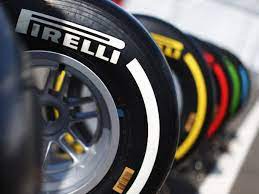
There are five tire compounds that Pirelli manufacture.
- F1 C1 tires – should last 30 to 50 laps.
- F1 C2 tires – should last 30 laps.
- F1 C3 tires – should last 30 laps.
- F1 C4 tires – should last 20 to 30 laps.
- F1 C5 tires – should last 10 to 20 laps
Pirelli designs the tires to last the stated number of laps. On race day the conditions may be very different and wear increases.
Soft tires will heat up very fast if the track temperatures
are higher than planned, making them last for a shorter time.
Similarly, hard tires normally heat up more slowly. If the track is cold, the warm-up time will be slower, which will wear the tire down earlier before it warms up.
There are five dry-weather tires that can choose.
Pirelli chooses two dry-weather tires for each race, and the teams get to choose the
last one.
The selected compounds are “Hard,” “Medium,” and “Soft,”. It depends on where they fall in the spectrum.
If C1, C2, and C3 are chosen, then.
- C2 will be called the “Medium” tire for the weekend.
- C3 will be called the “Soft” tire for the weekend.
If C3, C4, and C5 are selected, then.
- C3 will be called the “Hard” tire for the weekend.
- C4 will be called the “Medium” tire for the weekend.
- C5 will be called the “Soft” tire for the weekend.
The “Hard” tire for the weekend gets a white stripe for identification purposes.
The medium gets a yellow band, and the soft, a red one.
How Many F1 Tires Do The Teams Get?
Every team gets 13 sets of dry weather tires for each weekend – two sets of hard compounds, three sets of medium tires, and eight sets of soft tires.
In addition to the dry-weather tires, the teams get four sets of intermediate tires (for when the track is transitioning between wet and dry) and three sets of wet compound tires.
The 13 sets of tires must last for the following sessions.
- Free Practice 1.
- Free Practice 2 (or the sprint race)
- Free Practice 3.
- The first qualifying session.
- The second qualifying session.
- The third qualifying session.
- The main event.
The Number Of Laps F1 Tires Last Is Dependent On Certain Factors
The factors which affect the life of an F1 tire include following.
- The category F1 Tire raced on.
- The racing circuit (how fast the straights are, the cornering characteristics and how abrasive the surface is.)
- The characteristics of each team’s car.
The Category F1 Tires Raced On?
There are five dry weather tires. There are also intermediate and wet weather tires for rainy conditions.
The dry weather compounds range between C1-C5.
Soft tires provide greater levels of grip at the expense of wear rates.
Hard tires provide slightly less grip but wear slower.
Each track has tires that are most suited for its own conditions.
C1 (Compound 1) F1 Tires
Tires classed as C1 tires are the hardest. This makes them useful for high-speed circuits. Other conditions that may make the first choice include circuits that have.
1. Fast corners.
2. Abrasive surfaces.
3. The climate means that the track temperature is very high.
C1 tires should last the longest and provide the fastest straight-line speed. The drawback is that it heats up the slowest and only gets to the correct operating temperature after a few laps.
C2 (Compound 2) F1 Tires
These tires are not as hard as C1 tires however, they are above C3, C4, and C5.
C2 tire’s are used on high-speed, fast cornering circuits. These generate a lot of heat. Each of these metrics is at a slightly lower level than C1.
Being less extreme than a C1 tire gives the strategy department more flexibility and a wider working margin.
C3 (Compound 3) F1 Tires
C3 tires are squarely in the middle of the tire range.
They are the best balance tire. Teams use them in every race, irrespective of the track conditions.
In circuits where teams use C1 tires, they call C3 tires “Soft.”
In circuits where teams use C5 tires, they call C3 tires “Hard.”
C4 (Compound 4) F1 Tires
This compound tire is the second softest compound.
Teams us on circuits with tight corners, colder temperatures, and slower speeds – think Monaco.
C5 (Compound 5) F1 Tires
At the bottom end of the range sit the C5 (softest) tires. Teams always designate these as “Soft.”
The Characteristics Of The Racing Circuit
The different circuits define the tire choice for a weekend.
One of the main factors affecting tire choice on a circuit is the amount of “downforce” that the teams have to build into their F1 car setup for the weekend.
Downforce is the pressure the car’s aerodynamic features impose on the track. Changes in downforce are achieved by adjusting the rear and front wings.
Tracks Requiring High Downforce
Tracks with many tight corners and fewer shorter straights require “high downforce.”
On these circuits, the car’s ability to run at an outright speed is less important than having high power for long straights.
In its hay day when Mercedes was the winning team, their car specialized in high-speed long straights. Other teams, Red Bull, in particular, managed to even the results on the slower, tight-cornering tracks.
Low Downforce Tracks
Tracks requiring a low downforce are characterized by higher maximum speed and faster corners.
The Characteristics Of Each Team’s Car
All design choices end up being a balance of factors. This is particularly true of F1.
Teams will vary the design characteristics of their cars to try and optimize the number of circuits at which they will be competitive.
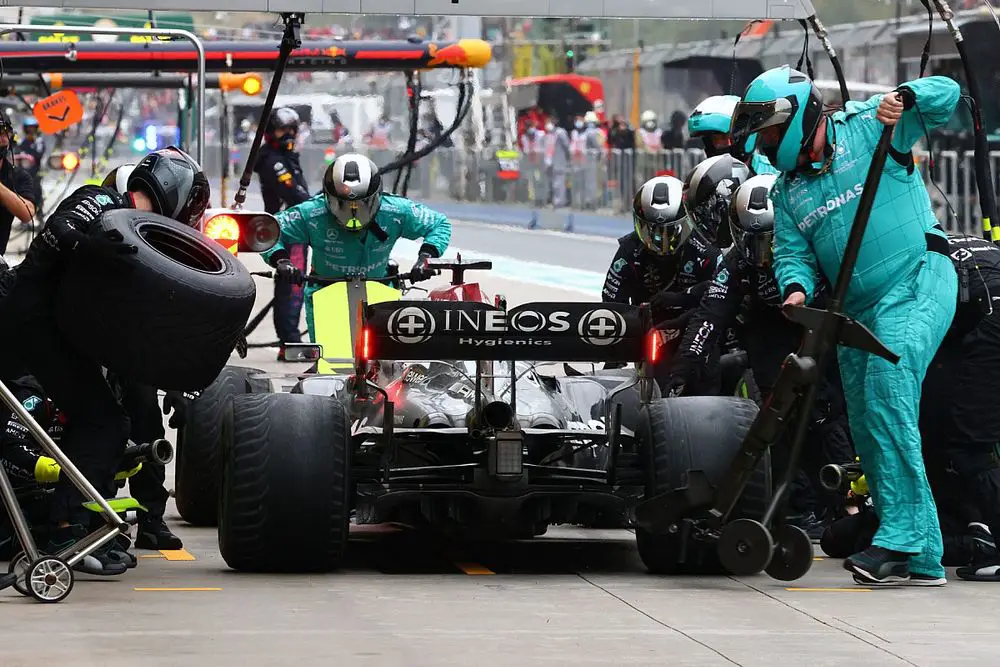
In 2022 Red Bull managed to build in the best balance of these differences, and the result was that they won the constructor’s championship with a margin to spare.
Cars that maximize the benefits of high-speed tracks will have a high downforce built into them. This is particularly true of the 2022 car, which reintroduced the concept of ground effect into the car’s design.
The higher the downforce, the greater the stress imposed on the F1 car tires. The result of this is that tires wear down faster.
Some teams have designed their cars for faster tracks with high-speed straights (Canada).
These cars have less downforce and tire wear; however, they are less nimble on the sharp and twisty corners.
While talking about the F1 car setup differences, you need to remember that the differences are very small.
A setup difference may result in an extremely small speed difference and times around the track.
The difference in qualifying times of the top three teams may be measured in 100th of a second.
By the time the 2021 season had drawn to a close, the cars raced more than 5,100 miles, yet the difference between the two top drivers (Lewis Hamilton and Max Verstappen) was only 9 seconds.
The Track Temperature
As discussed earlier, the hotter the track surface temperature, the faster the tires will wear.
Races in middle eastern countries will experience higher wear rates and tire degradation.
How Do The F1 Teams Use The Tires Over An F1 Weekend?
The following list is produced from Pirelli’s own estimates of the lap time difference each type of tire produces.
- The difference between the C1 to C2 tires is 0.8-1.0 seconds.
- The difference between the C2 to C3 tires is 0.7 seconds.
- The difference between the C3 to C4 tires is 0.6 seconds.
- The difference between the C4 to C5 tires is 0.6 seconds.
The F1 teams are instructed at each event to comply with the following tire parameters.
- The tire pressures at the start of the race.
- The maximum temperatures that can use in the heat blankets (will these be eliminated in 2023?
- The camber angle of the F1 car wheels.
A different set of values are provided to each team by Pirelli, which they arrive at based on the teams’ data points.
In past seasons some teams have made very costly mistakes in relation to their tire usage.
The following examples of bad choices or failed tires affected race results and even some championships.
The 1986 Australia Grand Prix
The left rear tire on Nigel Mansels blew out on the final straight, costing him, not only the race but also the championship.
1993 German Grand Prix
Damon Hills left rear tire developed a puncture in the German Grand Prix. which he was leading at the time. It resulted in him not finishing the race.
The 2005 European Grand Prix
The front right tire on Kimi Raikkonen’s, blew out, costing him first place and preventing him from finishing the race.
The 2007 Chinese Race
The rear right tire of Lewis Hamilton’s Williams car blew out, causing him to lose the lead and end up not finishing.
The 2010 Spanish Grand Prix
When he ran in second place, the left front tire on Louis Hamilton’s Mercedes developed a puncture.
The result was that he lost the podium position he was aiming for.
The 2013 Silverstone Grand Prix
Lewis Hamilton’s Mercedes developed a puncture in the rear left tire. The result of this was that he failed to finish.
The 2017 Silverstone Grand Prix
Both Ferraris (driven by Kimi Raikkonen and Sebastian Vettel) developed punctures.
The incident cost Sebastian Vettel his championship lead.
The 2018 Azerbaijan Grand Prix
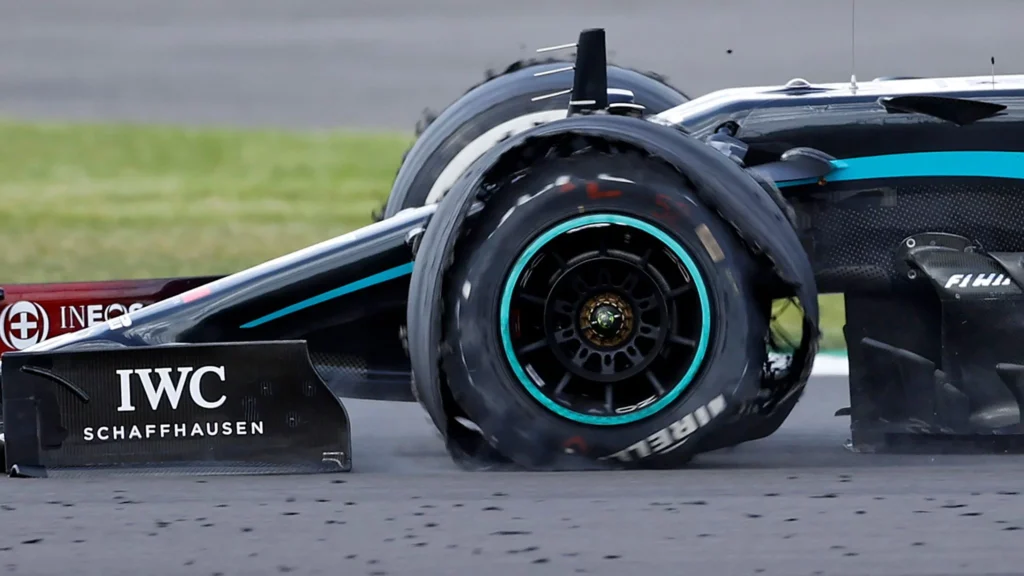
The Mercedes, driven by Valtteri Bottas, was in front of the pack when the right rear tire had a blowout.
Hamilton went on to win the race.
The 2020 Silverstone Grand Prix
Perhaps the most dramatic tire failure events happened at this event. It affected both Mercedes drivers.
Valtteri Bottas had to give up his position to Max Verstappen (Red Bull) when he had a puncture in the front left tire.
The most dramatic part of the event occurred when Louis Hamilton’s front left tire blew out on the last lap.
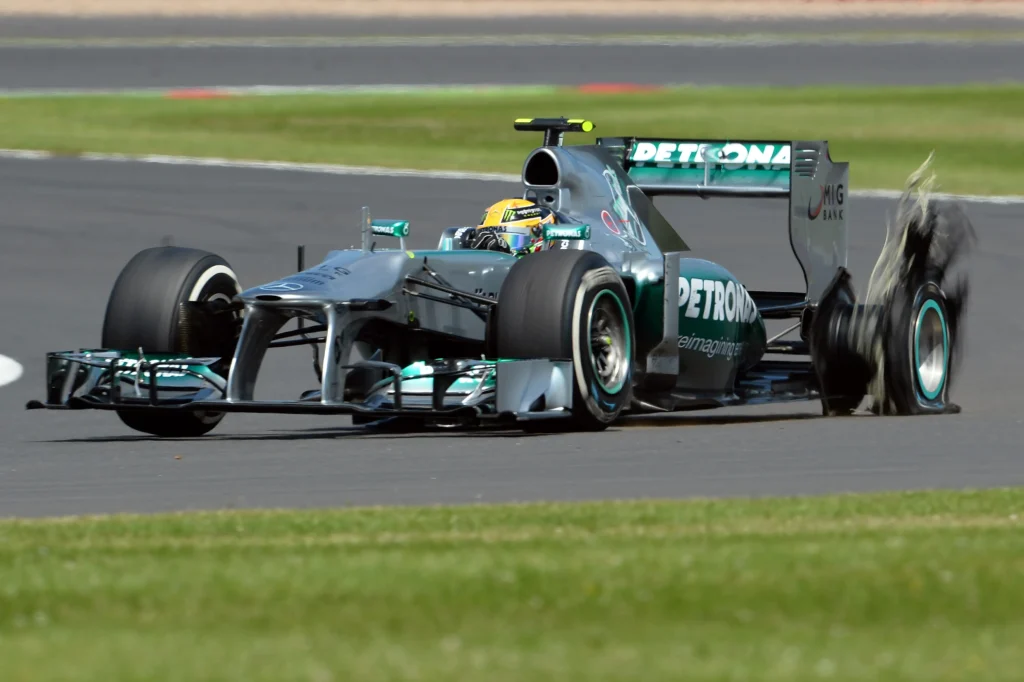
He kept his car running and won the race, albeit at a slightly slower speed.
What’s Happening With Tires In The 2023 Season?
In 2023 the tire compounds are being slightly adjusted to improve the understeer balance.
The changes include attempting to improve the tire grip of the C1 compound to bring it closer to the ability of the current C2 tire.
The C3 tire is being changed to make it fall evenly between the C2 and C4 tires giving it a performance bias closer to the soft tires.
The tires are also designed to be installed into cars with lower blanket temperatures. It will reduce the tire blanket temperature from 70C to 50C.
This was originally introduced in preparation for 2024, when a tire blanket ban was envisaged.
There is no certainty that the tire blanket bans will be imposed.
Pirelli gathered the data needed for these changes during the second Free Practice session during the Austin weekend.
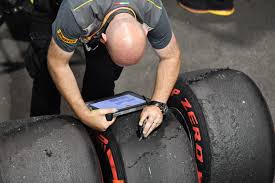
Interestingly, the teams were not told what compounds they were running, which enabled Pirelli to obtain the results without interference from the teams.
Conclusion
F1 tires are often the unsung heroes or villains in Formula One. How they perform can often be the deciding factor affecting the race’s outcome.
References
https://en.wikipedia.org/wiki/Formula_One_tyres

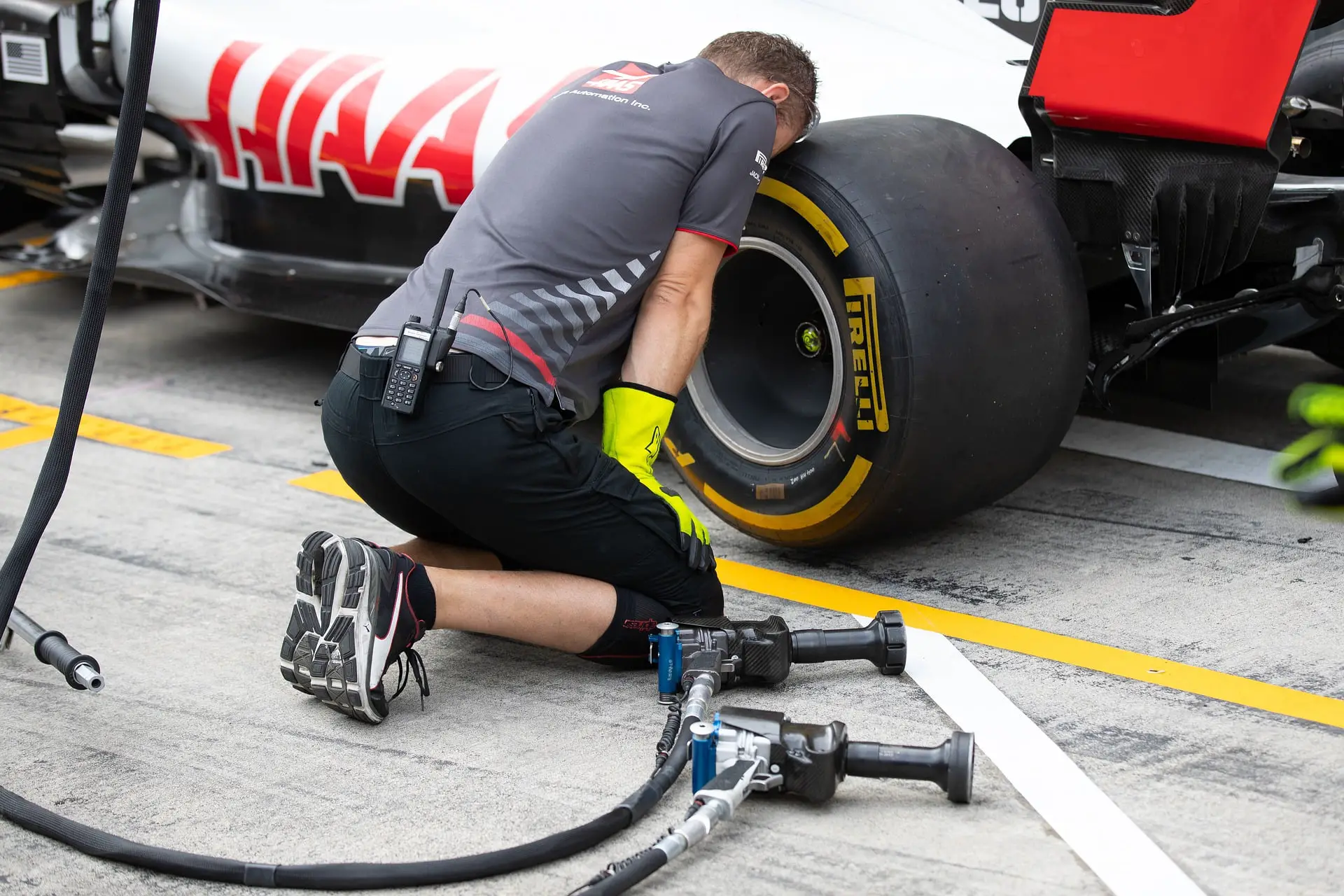
Superb website you have here but I was wondering if you knew of any discussion boards that cover the same topics discussed in this
article? I’d really love to be a part of community where I can get responses from other experienced people that share the same interest.
If you have any recommendations, please let me know.
Many thanks!
Your point of view caught my eye and was very interesting. Thanks. I have a question for you.
Reading your article helped me a lot and I agree with you. But I still have some doubts, can you clarify for me? I’ll keep an eye out for your answers.
Thanks for the feedback! That’s an interesting point. I suppose there are many reasons, internal and external, why we do not accomplish all that we might. Regardless, I am thankful for the Lord’s grace in that. Thanks again!
I agree with your point of view, your article has given me a lot of help and benefited me a lot. Thanks. Hope you continue to write such excellent articles.
Great post – can Zi subscribe?